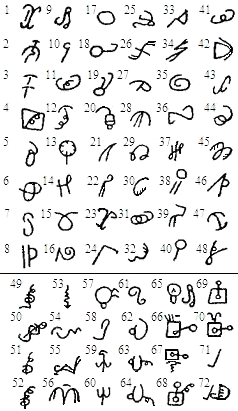Tenevil on:
[Wikipedia]
[Google]
[Amazon]
{{more citations needed, date=February 2015
 Tenevil (russian: Теневиль) (ca. 1890–1943?) was a Chukchi reindeer herder, living in the tundra near the settlement of
Tenevil (russian: Теневиль) (ca. 1890–1943?) was a Chukchi reindeer herder, living in the tundra near the settlement of
A Dream in Polar Fog
' to Tenevil.
 Tenevil (russian: Теневиль) (ca. 1890–1943?) was a Chukchi reindeer herder, living in the tundra near the settlement of
Tenevil (russian: Теневиль) (ca. 1890–1943?) was a Chukchi reindeer herder, living in the tundra near the settlement of Ust-Belaya
Ust-Belaya (russian: Усть-Бе́лая; ckt, Куулючьын, ''Kuulûč’yn'') is a rural locality (a '' selo'') in Anadyrsky District of Chukotka Autonomous Okrug, Russia, located at the confluence of the Anadyr and the Belaya Rivers.S ...
in Russian province of Chukotka.
Around 1927 or 1928 he independently invented a writing system for the Chukchi language
Chukchi , also known as Chukot, is a Chukotko-Kamchatkan languages, Chukotko–Kamchatkan language spoken by the Chukchi people in the easternmost extremity of Siberia, mainly in Chukotka Autonomous Okrug. The language is closely related to Koryak ...
. It has never been established with certainty whether the symbols in this writing system were ideograms
An ideogram or ideograph (from Greek "idea" and "to write") is a graphic symbol that represents an idea or concept, independent of any particular language, and specific words or phrases. Some ideograms are comprehensible only by familiarit ...
/pictograms
A pictogram, also called a pictogramme, pictograph, or simply picto, and in computer usage an icon, is a graphic symbol that conveys its meaning through its pictorial resemblance to a physical object. Pictographs are often used in writing and gr ...
or whether the system was logogram
In a written language, a logogram, logograph, or lexigraph is a written character that represents a word or morpheme. Chinese characters (pronounced ''hanzi'' in Mandarin, ''kanji'' in Japanese, ''hanja'' in Korean) are generally logograms, as ...
-based. Researchers have noted the abstract character of the symbols, which may be an indirect evidence that this writing system is entirely Tenevil's invention.
Tenevil's writing system was first described by the Russian ethnographer and writer Waldemar Bogoras
Vladimir Germanovich Bogoraz (russian: Влади́мир Ге́рманович Богора́з), who was born Natan Mendelevich Bogoraz (russian: Ната́н Ме́нделевич Богора́з) and used the literary pseudonym N. A. Tan ( ...
in 1930. The writing system was never widely known: it was used entirely within Tenevil's family encampment. Apart from Tenevil himself, the writing system was used by his son, with whom he exchanged messages during shifts away at the reindeer pastures. Tenevil wrote his symbols on boards, bones, walrus tusks, and candy wrappers.
This writing system is a unique phenomenon, and has wider significance to the research into the origins of writing traditions in the cultures in the pre-state stage of development. Tenevil's Chukchi writing system is the most northerly of all such systems to be developed by indigenous people with minimal outside influence.
The sources and prototype of the Tenevil writing system are unknown. Taking into consideration the isolation of Chukotka from the regional centres of civilization, it could be considered a localized creative initiative of a lone genius. It is possible the writing system is influenced by the decorations on shaman
Shamanism is a religious practice that involves a practitioner (shaman) interacting with what they believe to be a spirit world through altered states of consciousness, such as trance. The goal of this is usually to direct spirits or spiritu ...
s' drums. The word ''writing'' (''kelikel'') in the Chukchi language
Chukchi , also known as Chukot, is a Chukotko-Kamchatkan languages, Chukotko–Kamchatkan language spoken by the Chukchi people in the easternmost extremity of Siberia, mainly in Chukotka Autonomous Okrug. The language is closely related to Koryak ...
has Tungusic parallels.
In 1945 the artist and art historian I. Lavrov visited the upper reaches of the Anadyr River
The Anadyr (russian: Ана́дырь; Yukaghir: Онандырь; ckt, Йъаайваам) is a river in the far northeast of Siberia which flows into the Gulf of Anadyr of the Bering Sea and drains much of the interior of Chukotka Autonomous ...
where Tenevil had lived. There he discovered the "Tenevil archive": a box, buried in the snow, containing relics of Tenevil's writing. Tenevil also developed symbols for numerals, using the base 20 counting system of the Chukchi language. About 1000 basic elements of the Tenevil writing system have been identified.
The Chukchi writer Yuri Rytkheu
Yuri Sergeyevich Rytkheu ( rus, Ю́рий Серге́евич Рытхэ́у, , ˈjʉrʲɪj sʲɪrˈɡʲe(j)ɪvʲɪtɕ rɨtˈxɛʊ; ckt, Ю́рий Серге́евич Рытгэ́в; 8 March 1930 – 14 May 2008) was a Chukchi writer, ...
dedicated his 1969 novel A Dream in Polar Fog
' to Tenevil.
See also
*Sequoyah
Sequoyah (Cherokee language, Cherokee: ᏍᏏᏉᏯ, ''Ssiquoya'', or ᏎᏉᏯ, ''Se-quo-ya''; 1770 – August 1843), also known as George Gist or George Guess, was a Native Americans in the United States, Native American polymath of the Ch ...
* Uyaquq
Uyaquq (also Uyaquk or Uyakoq; sometimes referred to in English as Helper Neck) (ca. 1860–1924) was a member of the Central Alaskan Yup'ik people, Yup'ik people who became a Elder (Christianity), Helper in the Moravian Church, noted for his ...
External links
* http://www.rbardalzo.narod.ru/4/chukot.htmlSources
* The original version of this page was translated from the Chukchi people 1890s births 1943 deaths Creators of writing systems Soviet inventors People from Chukotka Autonomous Okrug